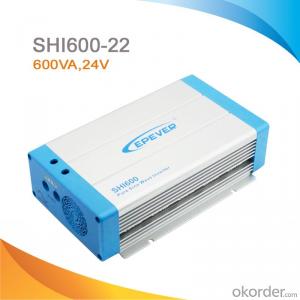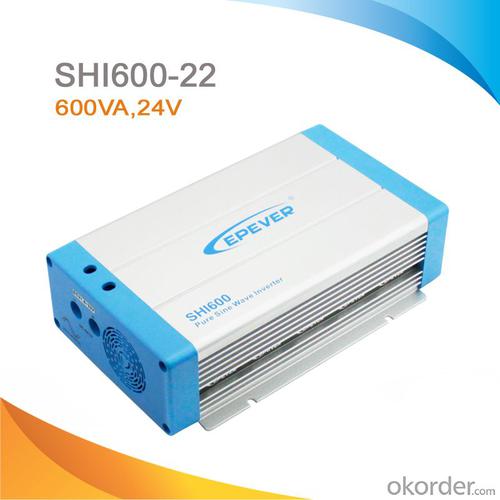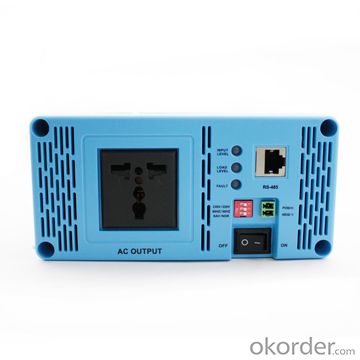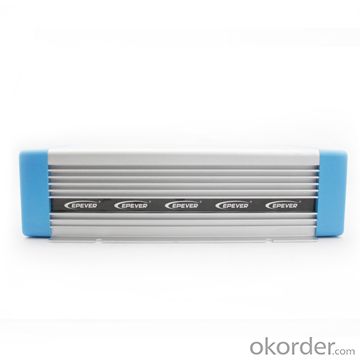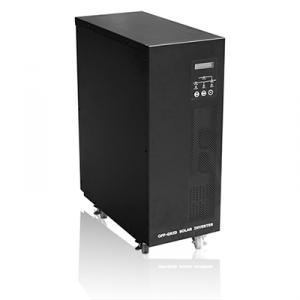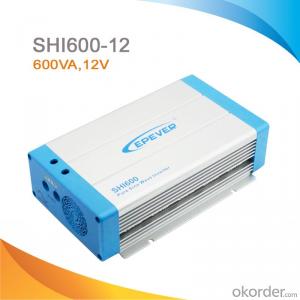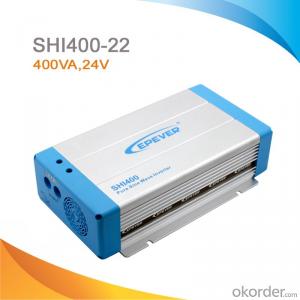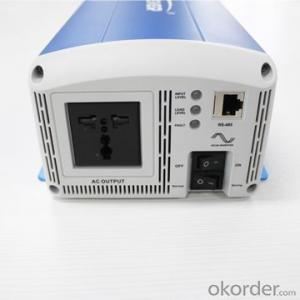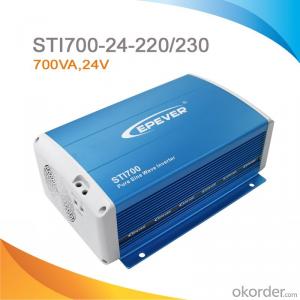500 Kw Solar Inverter - High Efficiency Off-Grid Pure Sine Wave Power Inverter 600W, 24V-220V/230V, SHI600-22
- Loading Port:
- China Main Port
- Payment Terms:
- TT or LC
- Min Order Qty:
- -
- Supply Capability:
- -
OKorder Service Pledge
OKorder Financial Service
You Might Also Like
Description
SHI series is a pure sine wave inverter which can convert 12/24/48Vdc to 220/230Vac 50/60Hz based on full digital and intelligent design. It features high reliability, high efficiency, concise outline, small volume, easy installation and operation. The inverter can be applied in many fields, such as household appliances, electric tools and industrial devices etc, especially for solar photovoltaic power system.

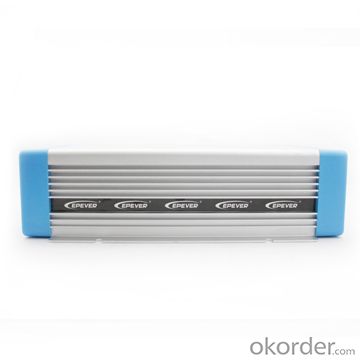
Features:
·Adoption of advanced SPWM technology, pure sine wave output
·Dynamic current loop control technology to ensure inverter reliable operation
·Wide DC input voltage range
·The output voltage and frequency can be switched
·Low output harmonic distortion(THD≤3%)
·LED indicators for input voltage range, load power range, normal output & failure state
·Optional energy saving mode
·Wide working temperature range (industrial level)
Protections:
·Output short circuit protection
·Overload protection
·Input low voltage protection
·Input over voltage protection
·Overheating protection
·Inverter abnormal protection
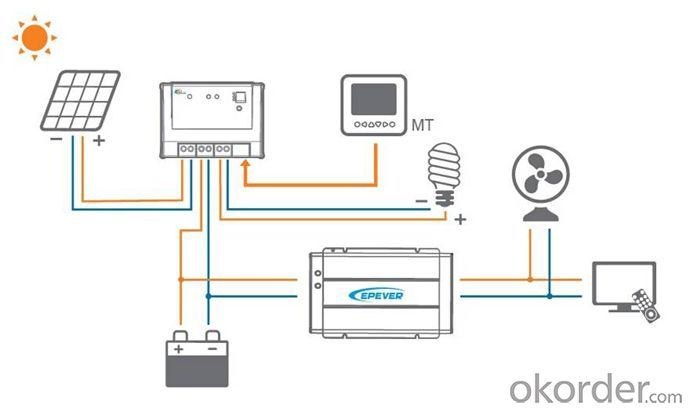
Specification:
Types | SHI600-12 | SHI600-22 |
Nominal Battery Voltage | 12V | 24V |
Input Voltage Range | 10.8~16Vdc | 21.6~32Vdc |
No Load Current | ≤0.7A | ≤0.45A |
Output Wave | Pure Sine Wave | |
Output Voltage | 220Vac±3% / 230Vac±10% | |
Continuous Power | 600W | |
Power 10 sec | 900W | |
Power 1.5 sec | 1200W | |
Surge Power | 1350W | |
Frequency | 50/60Hz±0.2% | |
Distortion THD | ≤ 3% (resistive load) | |
Efficiency at Rated Power | ≥91% | ≥92% |
Max. Efficiency | ≥93% | ≥94% |
Terminal | 25mm2 | |
Dimensions | 295×186×82mm | |
Installation | 150×178mm | |
Hole Size | Φ6mm | |
Net Weight | 2.3kg | |
Working Temperature | -20℃~ +50℃ | |
Storage Temperature | -35℃~ +70℃ | |
Humidity | < 95% (N.C.) | |
Altitude | < 5000m(Derating to operate according to IEC62040 at a height exceeding 1000m) | |
Insulation Resistance | Between DC input terminals and metal case: ≥550MΩ; Between AC output terminals and metal case: ≥550MΩ. | |
Dielectric Strength | Between DC input terminals and metal case: Test voltage AC1500V, 1 minute Between AC output terminals and metal case: Test voltage AC1500V, 1 minute | |
FAQ
Q: Off Grid VS On Grid Panels, what's the difference?
The differences between both panels are related to the system where they are going to be installed.
On-grid installations, as the name said, are thought to feed the produced energy into the grid and for that it is important to have the biggest voltage that it is allowed (1000VDC in Europe, 600 VDC in USA). For a defined power, more voltage means less current (P=V*I) and less losses.
In off-grid installations it is different because you must storage the energy into batteries. Batteries usually work at 12, 24 or 48 VDC and off-grid photovoltaic modules work at the maximum power point (mpp) near this voltage (see the datasheets). So the controller that charges the batteries works also near the batteries voltage.
Your limiting factor here is going to be this controller. You have to see what is the maximum voltage and the maximum current that it can work with, upstream (photovoltaic modules) and downstream (batteries and inverter). Then you have to dimension your PV array (Voltage and Current).
- Q: Can a solar inverter be used in grid-tied systems?
- Yes, a solar inverter can be used in grid-tied systems. In fact, it is a crucial component of such systems as it converts the DC power generated by solar panels into AC power that can be fed into the electrical grid.
- Q: Can a solar inverter be used with a string inverter system?
- No, a solar inverter and a string inverter system are two different types of inverters used in solar power systems. They cannot be used interchangeably as they have different functionalities and are designed for different types of solar installations.
- Q: What is the role of reactive power control in a solar inverter?
- The role of reactive power control in a solar inverter is to manage and optimize the flow of reactive power between the solar PV system and the grid. This control allows the inverter to regulate the power factor, which is the ratio of real power to apparent power, ensuring that the system operates efficiently and in compliance with grid requirements. By adjusting the reactive power output, the inverter can compensate for voltage fluctuations and stabilize the grid, improving the overall performance and reliability of the solar power generation system.
- Q: What is the efficiency loss of a solar inverter over time?
- The efficiency loss of a solar inverter over time can vary depending on various factors such as the quality of the inverter, maintenance practices, and environmental conditions. Generally, solar inverters experience a gradual decrease in efficiency over their lifespan. On average, the efficiency loss can range from 0.5% to 1% per year. However, regular maintenance and monitoring can help minimize this loss and ensure optimal performance.
- Q: Can a solar inverter be used with a solar water pumping system?
- Yes, a solar inverter can be used with a solar water pumping system.
- Q: How does a solar inverter handle voltage sag or drop in the grid?
- A solar inverter handles voltage sag or drop in the grid by constantly monitoring the grid voltage. When it detects a drop in voltage, it adapts its operation to ensure that the output voltage from the solar panels matches the grid voltage, thereby stabilizing and compensating for the voltage sag or drop. This helps to maintain a consistent and reliable power supply from the solar panels to the grid.
- Q: What is the role of an anti-islanding feature in a solar inverter?
- The role of an anti-islanding feature in a solar inverter is to ensure the safety of utility workers by preventing the solar system from continuing to generate power during a grid outage. It detects when the grid goes down and immediately disconnects the solar system from the grid, preventing any potential harm or damage that could occur if power is still being fed into the grid.
- Q: What is the maximum power capacity of a solar inverter?
- The maximum power capacity of a solar inverter can vary depending on the model and specifications, but it is generally in the range of a few kilowatts to several megawatts.
- Q: How does a solar inverter handle voltage regulation during high demand?
- A solar inverter handles voltage regulation during high demand by constantly monitoring the grid voltage and adjusting its output accordingly. When there is high demand, the inverter ramps up its power output to ensure that the voltage remains stable and within the acceptable range. It does so by regulating the reactive power flow and employing advanced control algorithms to maintain grid stability.
- Q: What is the difference between a single-phase and three-phase solar inverter?
- A single-phase solar inverter is designed to convert the DC power generated by solar panels into AC power for use in single-phase residential or small-scale commercial applications. It typically has one input and one output, and is suitable for systems with a single-phase electrical supply. On the other hand, a three-phase solar inverter is designed to convert DC power into AC power for use in three-phase electrical systems, which are commonly found in larger commercial or industrial settings. It has three inputs and three outputs, allowing for a more balanced distribution of power across the phases. In summary, the main difference between a single-phase and three-phase solar inverter lies in their compatibility with different electrical systems. Single-phase inverters are suitable for smaller-scale applications, while three-phase inverters are better suited for larger-scale installations with three-phase power supply.
Send your message to us
500 Kw Solar Inverter - High Efficiency Off-Grid Pure Sine Wave Power Inverter 600W, 24V-220V/230V, SHI600-22
- Loading Port:
- China Main Port
- Payment Terms:
- TT or LC
- Min Order Qty:
- -
- Supply Capability:
- -
OKorder Service Pledge
OKorder Financial Service
Similar products
Hot products
Hot Searches
Related keywords
